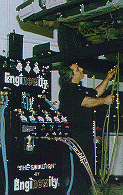Engine Renewal System Relies on Brass Fittings
 Decontaminating a car's engine with the Enginewity system, which contains hundreds of brass fittings that protect the system from the decontaminants used.
Decontaminating a car's engine with the Enginewity system, which contains hundreds of brass fittings that protect the system from the decontaminants used.A new system that revives flagging engines depends on hundreds of brass fittings. The system removes efficiency robing contamination from four components of internal combustion engines: the lubrication system, the cooling system, fuel injectors and the catalytic converter.
The standard brass fittings in the system are made by Flare Fittings and Parker Hannifin out of free-machining C36000 and supplied to Enginewity by Tyson Bolt, Tampa, Florida.
Brass was selected over other metals "because it is neutral to the cleaning fluids used in our system," according to John Macaluso, director of engineering. Brass fittings enjoy another advantage over steel fittings: they cost less. "Although engine power does increase after the first 12,000 to 15,000 miles, after about 50,000 miles, the average well-maintained vehicle has lost about 20% of its engine's power and efficiency due to buildup of contaminants; our process safely reverses the loss of performance," claims Holtz.
To back up his claim, Enginewity submitted reports from many customers. One, Piedmont Natural Gas, Greenville, South Carolina, had two well-maintained Chevrolets processed. Both were tested before and after on a Clayton Chassis Dynamometer. One, with an odometer reading of 68,480, showed a 13% increase in power, while the second, with 53,965 miles, showed an 8% increase.
 The back of the system removed to show some of the hundreds of brass fittings.
The back of the system removed to show some of the hundreds of brass fittings.E.E. Austin & Son, Inc., a construction firm in Erie, Pennsylvania, submitted a large diesel in an air compressor to the process. Dan Bennett, service manager, reported "...a noticeable ease in startability, particularly in cold weather, and elimination of engine run-on (dieseling)."
Enginewity, Clearwater, FL, 800/288-6656
Flare Fittings, Kalamazoo, MI, 616/344-7600
Parker Hannifin, Otsego, MI 616/694-9411
Also in this Issue:
- Copper Screens Repel Clogging Mussels
- Copper Alloys Tools Prevent Dangerous Explosions
- Engine Renewal System Relies on Brass Fittings
- Copper Blocks RFI Both Ways
